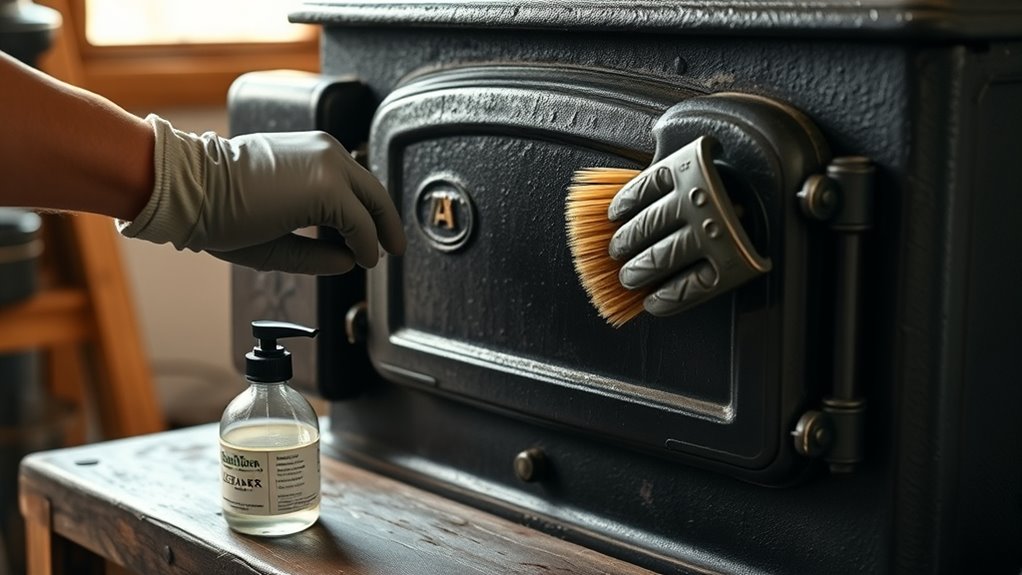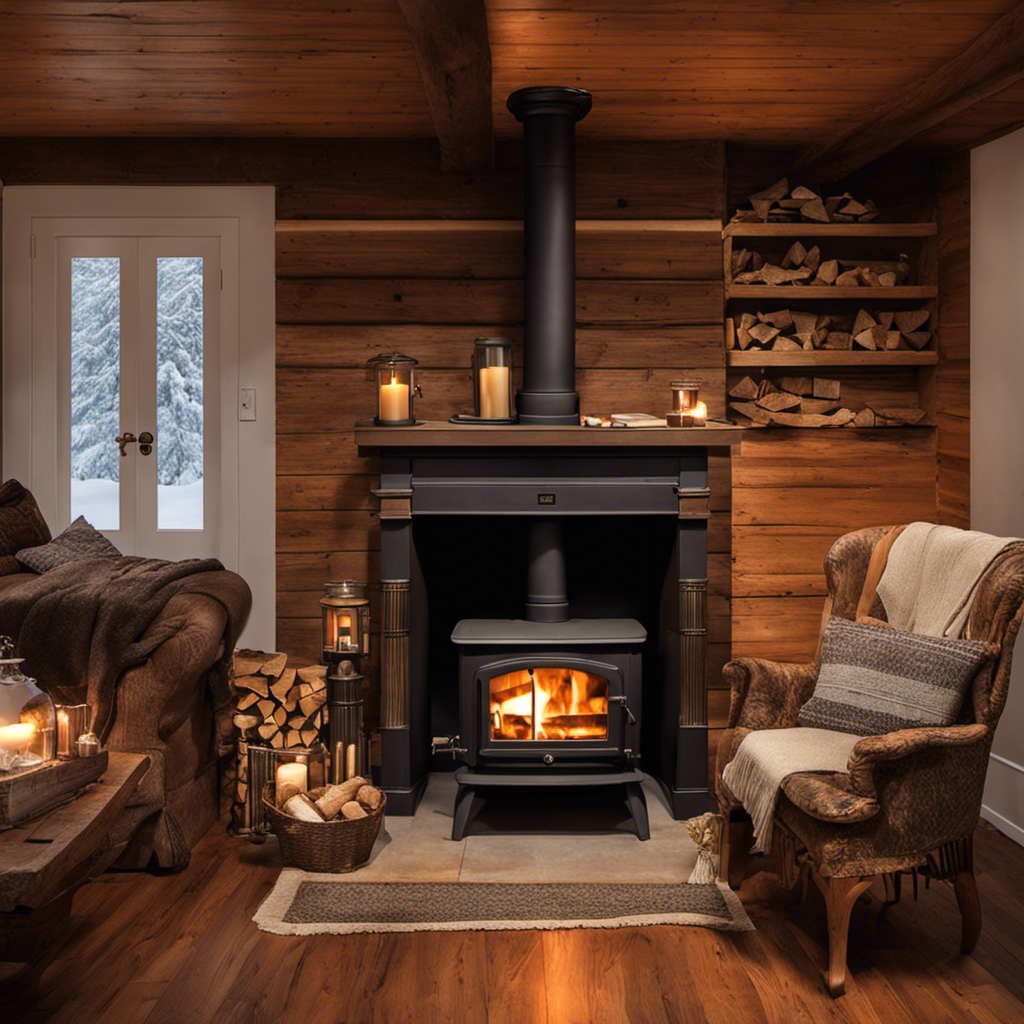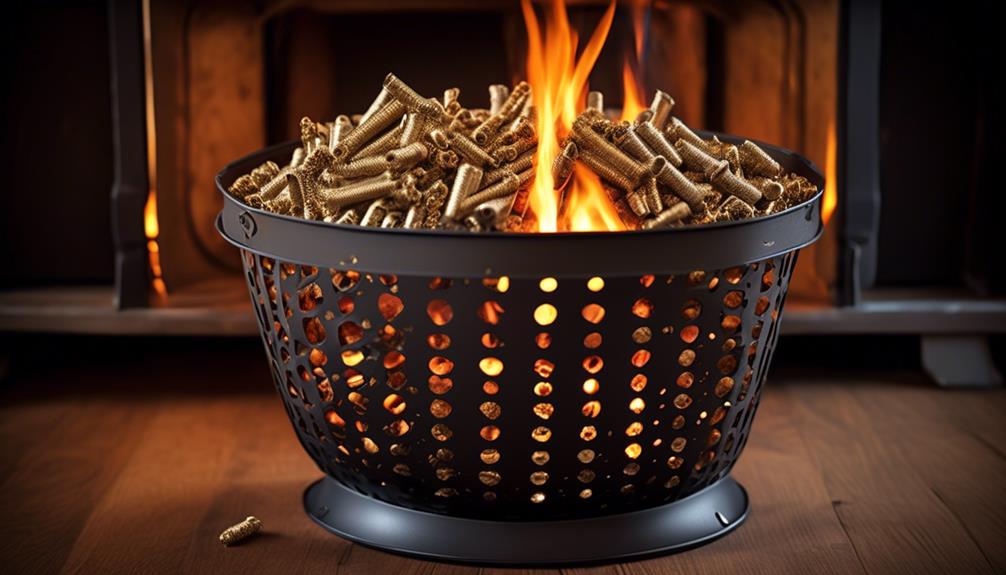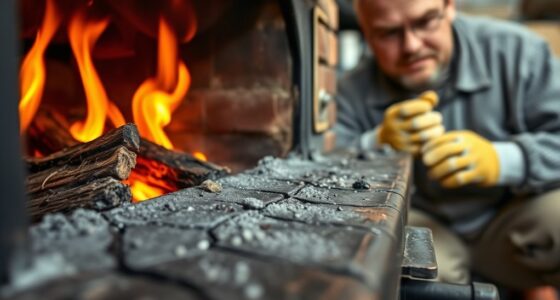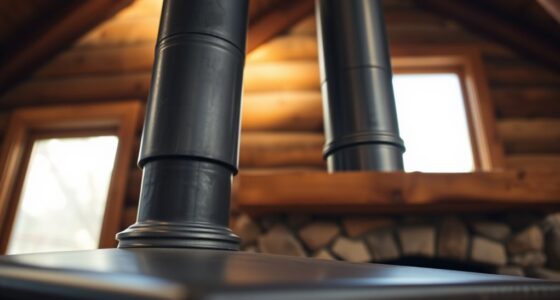To clean your wood stove properly, start by turning it off and letting it cool completely. Remove ashes safely using a metal container and inspect internal parts like gaskets, hinges, and the glass door for wear or damage. Clear soot from surfaces and clean the glass with appropriate cleaners. Check your chimney and flue for creosote buildup. By following these steps, you’ll assure your stove operates safely and efficiently—keep going for detailed tips on each step.
Key Takeaways
- Ensure the stove is completely cool before cleaning and inspecting internal components and glass.
- Remove ashes using a metal container, dampen to eliminate embers, and clean regularly to prevent buildup.
- Clean the exterior, handles, vents, and glass door with a soft cloth and mild soap or specialized cleaners.
- Check and replace damaged gaskets, inspect chimney and flue for creosote buildup, and perform professional chimney sweeping annually.
- Reassemble all parts securely, verify seals and door closures, and schedule regular maintenance for safety and efficiency.
Prepare Your Stove for Cleaning
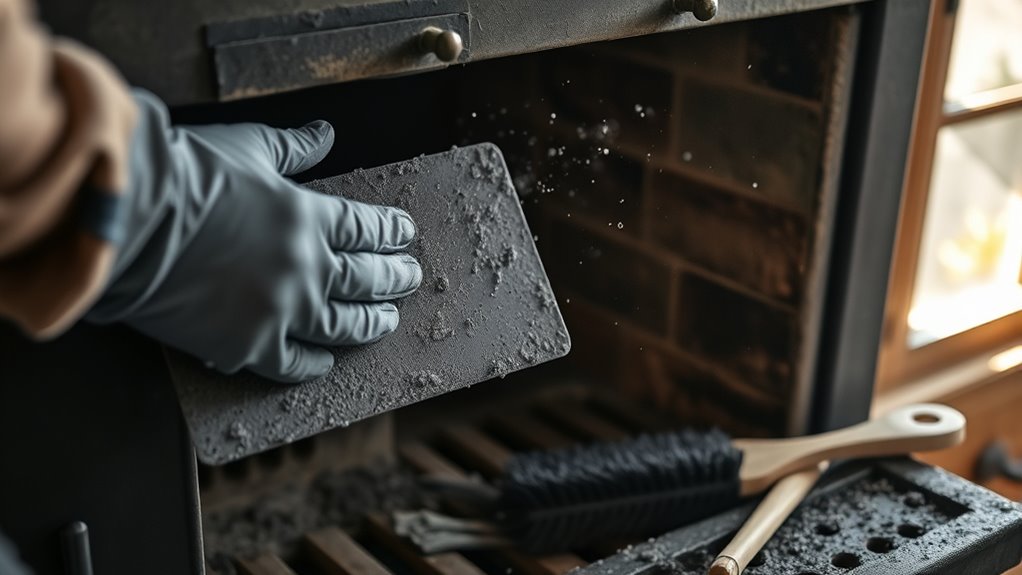
Before you begin cleaning your wood stove, make sure it’s completely cool to the touch to avoid burns or damage. Start by removing the ash pan and emptying it into a metal container, ensuring all ashes are fully cooled first. This step is essential to keep your stove clean and prevent ash buildup. Next, detach or open the stove door and remove any removable parts like baffles or firebricks for easier cleaning. Use a soft brush or vacuum with a brush attachment to clear loose soot and debris from inside the stove. Having the right tools, such as a damp cloth and a stove glass cleaner, helps you clean your stove thoroughly. Preparing your stove properly ensures safe, effective maintenance and prolongs its lifespan.
Remove and Dispose of Ashes Safely
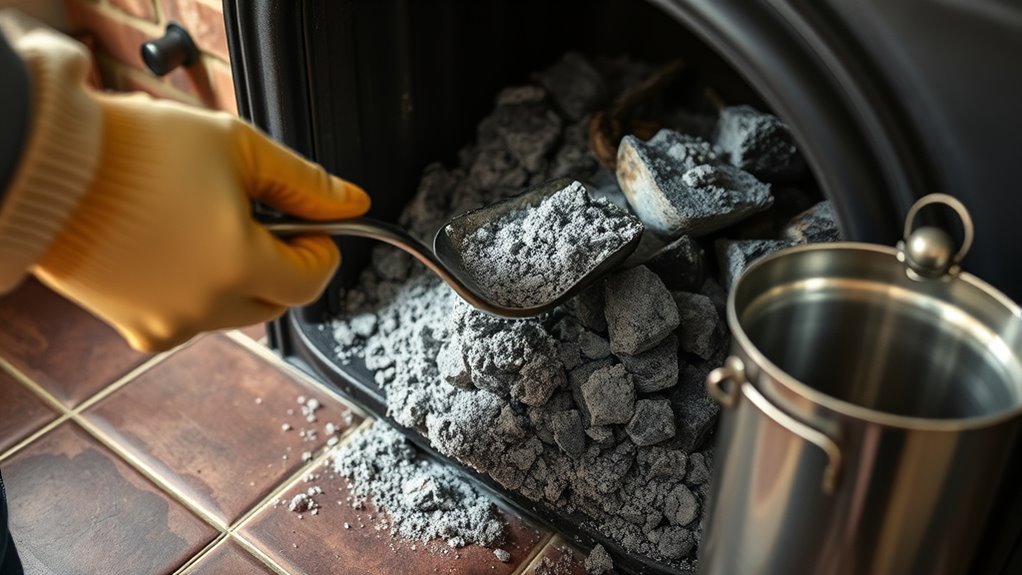
Once you’ve finished preparing your stove for cleaning, it’s important to remove and dispose of the ashes safely. Always wait until the ashes are completely cooled before handling them to prevent fire hazards. Use a metal, heat-resistant container with a tight-fitting lid to contain the ashes securely. Dampen the ashes with water or a spray bottle to eliminate lingering embers and reduce dust. Remove the cooled ashes regularly, ideally when the fire is out and the stove is cool, to keep airflow and efficiency *maximized*. Proper disposal of ash is crucial to prevent any potential fire risk, especially if the ashes contain residual embers. Additionally, understanding proper tuning techniques for your vehicle’s engine can help ensure your stove operates efficiently and safely, similar to how well-tuned engines perform optimally. Regularly inspecting your stove’s ventilation system can also help maintain optimal performance and safety. Maintaining good ventilation can reduce the buildup of harmful pollutants and improve overall stove efficiency. Incorporating regular maintenance practices can further enhance safety and efficiency during stove operation.
Clean the Stove Surface and Exterior
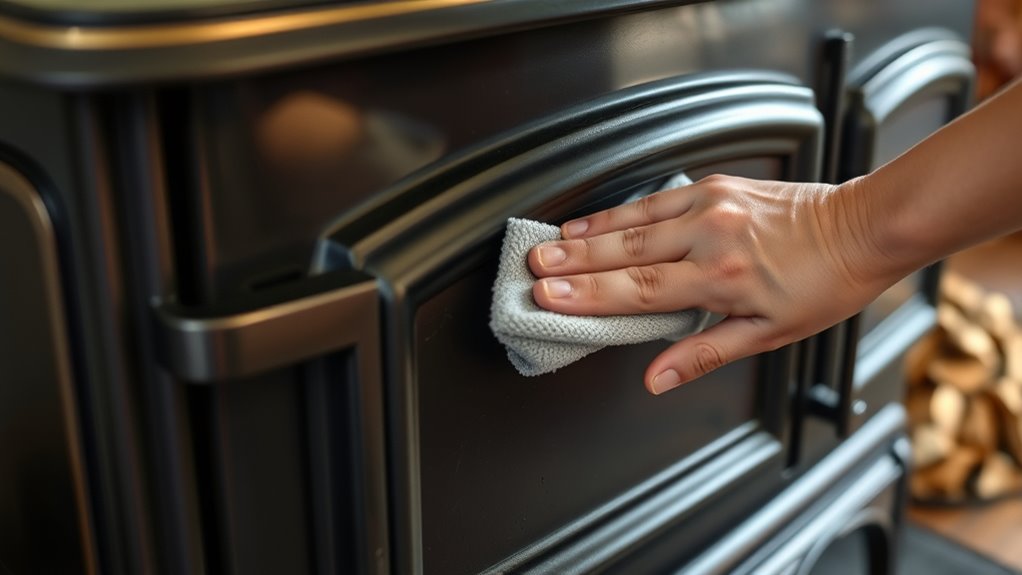
To keep your wood stove looking its best and functioning safely, it’s essential to clean the surface and exterior regularly. Proper stove cleaning prevents dust buildup and maintains its appearance. Always ensure the stove is completely cool before starting. Use a soft brush or microfiber cloth with a vacuum to gently remove soot, dust, and dirt. For stubborn stains, dampen the cloth with water or a mild soap solution—avoid abrasive cleaners that can scratch the surface. Regularly wipe down the exterior after each use to prevent buildup. Pay close attention to handles, vents, and seams, making sure they’re free of debris for safety and performance. Incorporating powerful persuasive words into your cleaning routine can motivate consistent maintenance. Staying informed about technological advancements in home safety can help you choose better cleaning tools and methods. Additionally, using environmentally friendly cleaning products supports sustainable living practices, ensuring your home stays safe and eco-conscious. Remember, father-child bonds are built on care and attention, just like maintaining your stove’s condition.
Clean the Glass Door Effectively
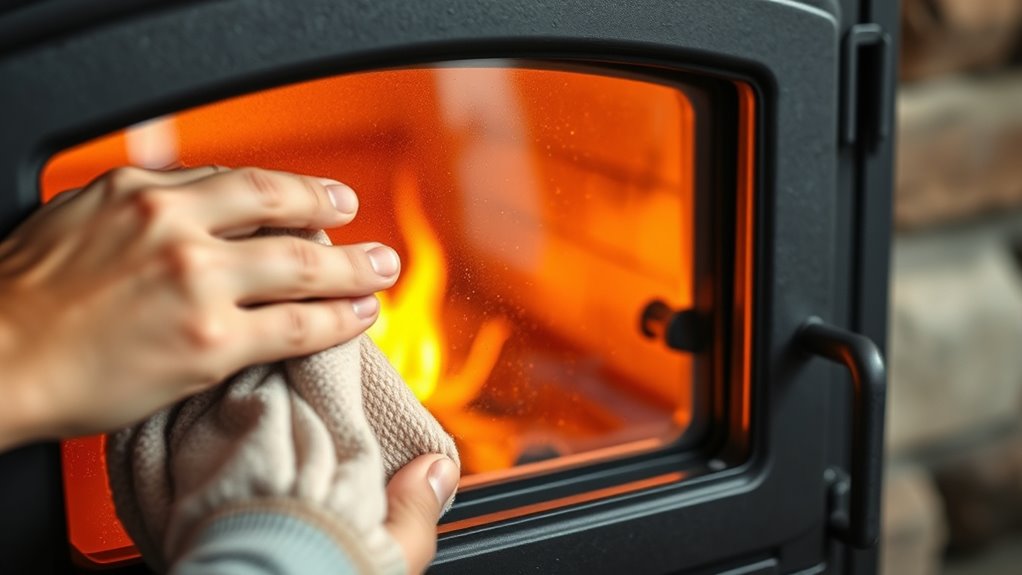
Cleaning the stove glass regularly keeps your view of the fire clear and helps your stove perform efficiently. To clean the glass, gently wipe away soot and dirt with a damp cloth dipped in soft ashes or a specialized glass cleaner. Burn well-seasoned, dry logs to reduce soot buildup and keep the glass cleaner longer. For stubborn stains, use a commercial wood stove glass cleaner or a diluted ammonia spray with a soft rag. Avoid abrasive pads or harsh chemicals to prevent scratching or damaging the glass surface. Regular cleaning not only improves visibility but also minimizes tar buildup, ensuring your stove runs smoothly. Consistent maintenance makes your wood stove safer, more efficient, and more enjoyable to use. Additionally, understanding wood stove operation can help prevent excessive soot and improve cleaning efficiency. Using appropriate cleaning techniques can further extend the lifespan of your stove’s glass and ensure a clear view of the fire. Proper stove glass care is essential to maintain the longevity and safe operation of your appliance.
Inspect and Replace Gaskets If Needed
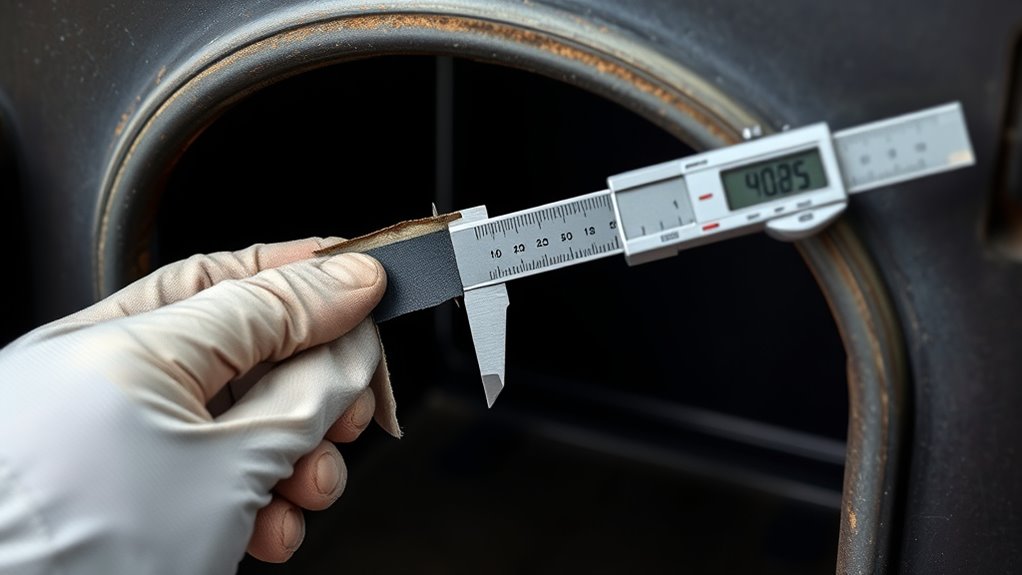
Inspecting your stove gaskets regularly is essential to guarantee a proper seal and peak performance. Worn or damaged gaskets can let heat and smoke escape, causing inefficiency and ash buildup. To check your gaskets:
- Look for brittleness, cracking, or fraying along the gasket edges.
- Ensure they sit securely in their grooves without gaps.
- Check for signs of ash or debris that may hinder sealing.
- Test the door closure—if it feels loose or hard to shut, replace the gaskets.
If you notice any issues, replace the gaskets with high-temperature, compatible material to restore airtightness. Proper gasket maintenance keeps your stove operating efficiently and safely, preventing ash and smoke leaks that could compromise performance.
Check and Clean the Chimney and Flue
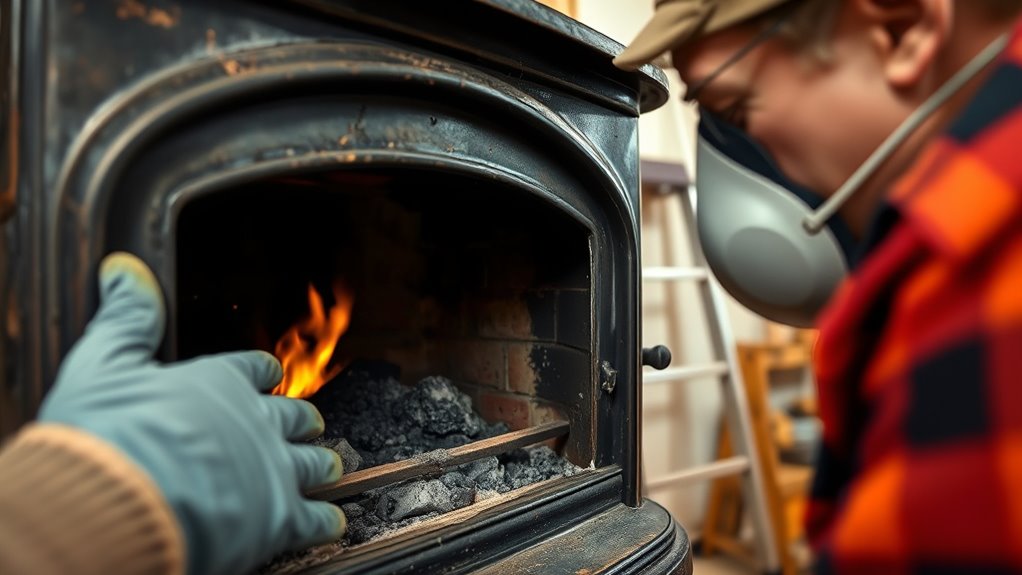
Regularly checking and cleaning your chimney and flue is essential for safe and efficient stove operation. Inspect the chimney pipe and flue for creosote buildup, which should stay under ⅛ inch thick to prevent fire hazards. Use a chimney brush and rods to scrub the interior from the bottom up, removing soot and deposits. Consider hiring professional chimney sweeps annually for a thorough cleaning and to spot issues like cracks or blockages. Always clean from inside the stove or from the top of the chimney, avoiding disassembly unless you’re experienced. Proper maintenance improves stove efficiency, reduces smoke emissions, and minimizes fire risks. Maintaining proper airflow is also crucial for optimal stove performance and safety. Additionally, ensuring proper ventilation can help prevent dangerous smoke buildup indoors. Regularly inspecting self-watering plant pots can prevent overwatering or root rot, similar to how regular chimney maintenance prevents buildup and hazards. Remember that installation guidelines emphasize the importance of proper venting and clearance to keep your stove operating safely and efficiently.
Maintain the Stove’s Seals and Hinges
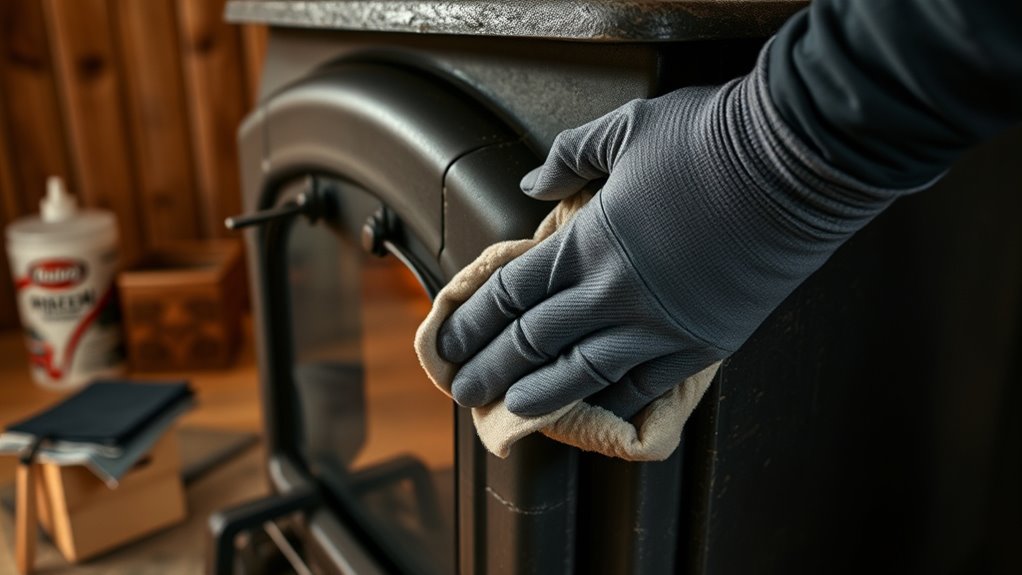
To guarantee your wood stove operates safely and efficiently, it’s essential to maintain the seals and hinges regularly. Start by inspecting the gasket surfaces for brittleness, tears, or wear. Replace worn gaskets promptly to ensure an airtight seal that maintains stove efficiency and prevents smoke leaks. Use a flashlight to check for gaps or leaks around hinges and seals, ensuring they close tightly each time. Clean gasket surfaces with a damp cloth to remove soot or debris that could compromise sealing ability. Regular maintenance of hinges prevents sticking or misalignment, keeping the door secure. Additionally, inspecting seal integrity can help identify potential issues before they become major problems. Remember these steps: 1. Inspect gasket surfaces for damage 2. Replace worn gaskets immediately 3. Check hinges for tightness and proper operation 4. Clean gasket surfaces regularly to maintain a secure seal. Furthermore, applying proper lubrication to hinges can prevent rust and ensure smooth operation. Additionally, consulting wood stove safety standards can help ensure your maintenance practices align with safety regulations. Properly inspecting and maintaining these components is also key for energy efficiency, preventing unnecessary heat loss and ensuring your stove performs optimally. Regular checks of sealing components are crucial for optimal stove performance and safety.
Reassemble and Final Checks
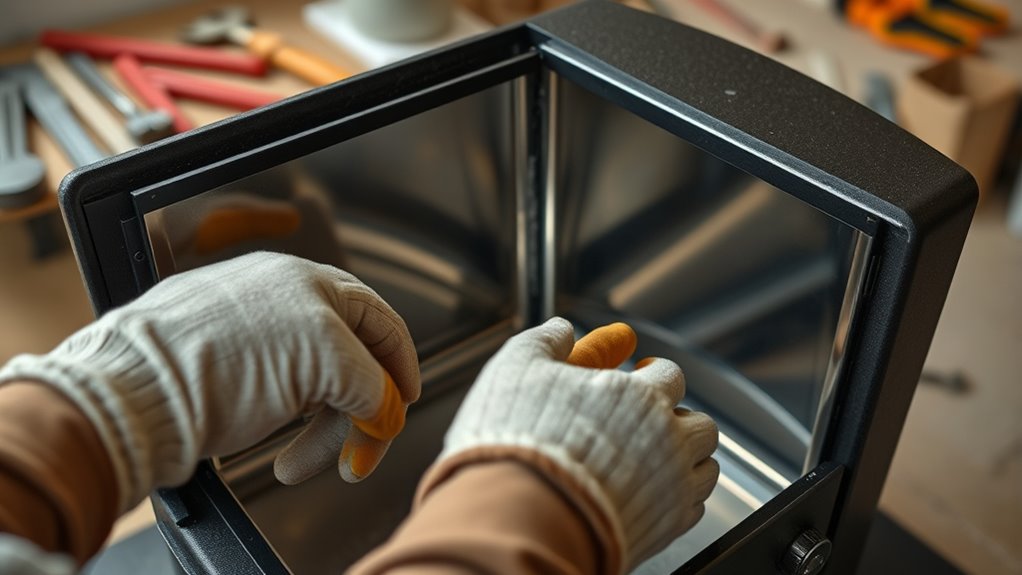
Before reassembling your wood stove, carefully check all cleaned components for signs of wear or damage, such as cracked gaskets or rusted parts. Make sure the gasket around the door is intact and creates a proper seal to prevent smoke leaks and maintain efficiency. When reinstalling the door, ensure it is properly seated and closes securely. Inspect the glass for cracks or chips, replacing if necessary, to keep the stove operating safely. Reinstall baffles, ash pans, and other internal parts according to the manufacturer’s instructions. Perform a final visual inspection, confirming all parts are correctly positioned and securely fastened. Regular maintenance and awareness of safety precautions are essential for safe operation. Proper reassembly guarantees your stove’s safe operation and peak performance before lighting a new fire. Additionally, always verify that the venting system is free of obstructions to ensure proper airflow and prevent potential hazards. Checking for airflow efficiency can help prevent creosote buildup and reduce fire risks, especially considering the weight of wind turbine blades that impacts energy systems and safety considerations.
Schedule Regular Maintenance and Professional Inspections
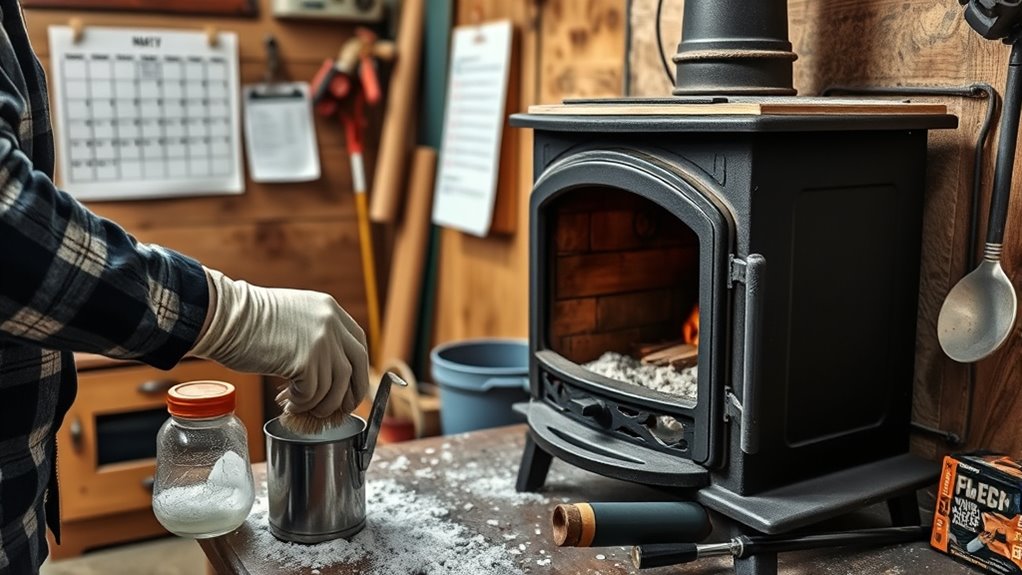
Scheduling regular maintenance and professional inspections is crucial to keep your wood stove operating safely and efficiently. An annual chimney inspection helps detect creosote buildup, reducing fire risks. Additionally, a thorough internal stove inspection ensures gaskets, seals, and components are in good condition. Keep a detailed maintenance log to track inspections, cleanings, and repairs, which helps identify recurring issues. Regularly cleaning the chimney and stovepipe before the heating season begins prevents dangerous creosote deposits. To guarantee safety and peak performance, consult a certified chimney sweep or stove technician for extensive assessments. By adhering to this schedule, you’ll maintain a safe, efficient stove and extend its lifespan. Proper maintenance is an essential part of responsible stove ownership.
Frequently Asked Questions
What Is the Best Thing to Clean a Wood Burning Stove?
When you want to clean your wood stove effectively, start with a soft brush and a damp cloth to wipe down the exterior and glass surfaces. Use a vacuum or purpose-built ash tool to remove ashes safely. For the glass, dedicated stove cleaner or damp ashes work best. Always guarantee the stove is cool before cleaning to avoid burns or damage, keeping your stove safe and efficient.
Do Wood Burning Stoves Need to Be Cleaned?
You might wonder if your wood stove needs cleaning, but neglecting it invites trouble. Regular cleaning keeps your stove efficient and safe, preventing dangerous creosote buildup and ensuring proper airflow. Just like you maintain your car for smooth operation, your stove needs routine care. Without cleaning, you risk smoke leaks, reduced heat output, and even fire hazards. So yes, cleaning isn’t optional—it’s essential for safe, effective heating.
What Is the Best Way to Clean the Outside of a Wood Burning Stove?
To clean the outside of your wood-burning stove, start by ensuring it’s cool. Use a soft brush or cloth to gently remove dust and soot, then dampen a cloth with mild soap and water for stubborn stains. Avoid harsh cleaners or abrasives. For a polished look, apply a heat-resistant stove polish or protective coating. Regular cleaning keeps your stove looking good and functioning efficiently.
How Often Should I Clean My Chimney on a Wood Stove?
Think of your chimney as the heart of your stove’s safety and efficiency. You should inspect and clean it at least once a year, but if you burn frequently or heavily, every 3 to 6 months is better. Watch for signs like smoke leaks or bad odors. Regular cleanings, especially with professional help, keep your chimney clear, ensuring safe, warm fires and a long-lasting system.
Conclusion
Think of cleaning your wood stove like tending a garden; regular care keeps everything thriving. When I neglected mine, creosote buildup nearly blocked the chimney, risking a dangerous fire. But after cleaning, I saw how proper maintenance acts like nourishing roots—preventing problems before they grow. By sticking to a routine, you guarantee your stove stays efficient and safe, allowing you to enjoy cozy fires without surprises. Regular upkeep is your best safeguard against unexpected mishaps.

